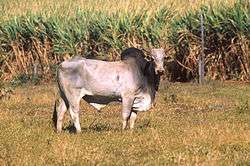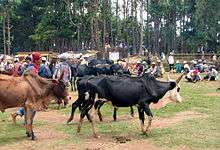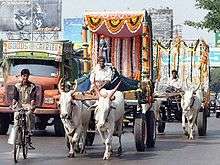Zebu
A zebu (/ˈziːb(j)uː, ˈzeɪbuː/; Bos primigenius indicus or Bos indicus or Bos taurus indicus), sometimes known as indicine cattle or humped cattle, is a species or subspecies of domestic cattle originating in South Asia. Zebu are characterised by a fatty hump on their shoulders, a large dewlap, and sometimes drooping ears. They are well adapted to withstanding high temperatures, and are farmed throughout the tropical countries, both as pure zebu and as hybrids with taurine cattle, the other main type of domestic cattle. Zebu are used as draught and riding animals, dairy cattle, and beef cattle, as well as for byproducts such as hides and dung for fuel and manure. Zebu, namely miniature zebu, are kept as companion animals. In 1999, researchers at Texas A&M University successfully cloned a zebu.[1]
| Zebu | |
|---|---|
 | |
Domesticated | |
| Scientific classification | |
| Kingdom: | Animalia |
| Phylum: | Chordata |
| Class: | Mammalia |
| Order: | Artiodactyla |
| Family: | Bovidae |
| Subfamily: | Bovinae |
| Genus: | Bos |
| Species: | |
| Subspecies: | B. t. indicus |
| Trinomial name | |
| Bos taurus indicus | |
| Synonyms | |
| |
Taxonomy and name
The scientific name of zebu cattle was originally Bos indicus, but they are now more commonly classified within the species Bos taurus as B. t. indicus, together with taurine cattle (B. t. taurus) and the extinct ancestor of both of them, the aurochs (B. t. primigenius).[2] Taurine ("European") cattle are descended from the Eurasian aurochs, while zebu are descended from the Indian aurochs. "Zebu" may be either singular or plural, but "zebus" is also an acceptable plural form. The Spanish name, cebu or cebú, is also present in a few English works.
Origin

.jpg)
Zebu cattle are thought to be derived from Indian aurochs, sometimes regarded as a subspecies, B. p. namadicus.[3] Wild Asian aurochs disappeared during the time of the Indus Valley Civilisation from its range in the Indus River basin and other parts of the South Asian region possibly due to interbreeding with domestic zebu and resultant fragmentation of wild populations due to loss of habitat.[4]
Phylogenetic analysis revealed that all the zebu Y-chromosome haplotypes groups are found in three different lineages: Y3A, the most predominant and cosmopolitan lineage; Y3B, only observed in West Africa; and Y3C, predominant in South and Northeast India. [5]
Archaeological evidence including depictions on pottery and rocks suggests that the species was present in Egypt around 2000 BC and thought to be imported from the Near East or south. Bos indicus is believed to have first appeared in sub-Saharan Africa between 700 and 1500 and was introduced to the Horn of Africa around 1000.[6]
Breeds and hybrids
Some 75 breeds of zebu are known, split about evenly between African breeds and Indian ones. The major zebu cattle breeds of the world include Gyr, Kankrej and Guzerat, Indo-Brazilian, Brahman, Sibi Bhagnari, White Nukra[7], Acchai[8], Cholistani, Dhanni, Lohani, Nelore, Ongole, Sahiwal, Red Sindhi, Butana and Kenana, Baggara, Tharparkar, Kangayam, Southern Yellow, Kedah-Kelantan and Local Indian Dairy (LID). Kedah-Kelantan and LID originated from Malaysia. Other breeds of zebu are quite local, like the Hariana of Haryana and eastern Punjab[9] or the Rath of Alwar in eastern Rajasthan.[10]
From the 1960s onwards, Nelore which is a off breed of Ongole Cattle became the primary breed of cattle in Brazil because of its hardiness, heat-resistance, and because it thrives on poor-quality forage and breeds easily, with the calves rarely requiring human intervention to survive. Currently more than 80% of beef cattle in Brazil (approximately 167,000,000 animals) are either purebred or hybrid Ongole Cattle which is originated from Ongle region of Andhra Pradesh.
The African sanga cattle breeds originated from hybridization of zebu with indigenous African humpless cattle; they include the Afrikaner, Red Fulani, Ankole-Watusi, Boran and many other breeds of central and southern Africa. Sanga cattle can be distinguished from pure zebu by their having smaller humps located farther forward on the animals.

Zebu were imported to Africa over many hundreds of years, and interbred with taurine cattle there. Genetic analysis of African cattle has found higher concentrations of zebu genes all along the east coast of Africa, with especially pure cattle on the island of Madagascar, either implying that the method of dispersal was cattle transported by ship or alternatively, the zebu may have reached East Africa via the coastal route (Pakistan, Iran, Southern Arabian coast) much earlier and crossed over to Madagascar. Partial resistance to rinderpest led to another increase in the frequency of zebu in Africa.
Zebu, which can tolerate extreme heat,[11] were imported into Brazil in the early 20th century and crossbred with Charolais cattle, a European taurine breed. The resulting breed, 63% Charolais and 37% zebu, is called the Canchim. It has a better meat quality than the zebu and better heat resistance than European cattle. The zebu breeds used were primarily Indo-Brazilian with some Nelore and Guzerat.
Another Charolais cross-breed with Brahmans is called Australian Charbray and is recognised as a breed in some countries.
Many breeds are complex mixtures of the zebu and various taurine types, and some also have yak, gaur, or banteng genes. Zebu are very common in much of Asia, including China, Pakistan, India, Nepal, Bangladesh and almost all countries in Southeast Asia. In Asia, taurine cattle are only found in the northern regions such as Japan, Korea, and Mongolia, possibly domesticated separately from the other taurine cattle originating from Europe and Africa). Other species of cattle domesticated in parts of Asia include yak, gaur, banteng, and water buffalo.
Characteristics
Zebu have humps on the shoulders, large dewlaps, and droopy ears.[12] Compared to taurine cattle, zebus are well adapted to the hot, dry environment of the tropics. Adaptations include resistance to drought and tolerance of intense heat and sunlight.[13]
Reproduction
Zebu are generally mature enough to begin reproducing around 44 months old. This is based on the development of their bodies to withstand the strain of carrying and lactation. Early reproduction can place too much stress on the body and possibly shorten lifespans. Carrying time of the calf averages at 285 days, but varies depending on the age and nutrition of the mother. The sex of the calf may also affect the carrying time, as male calves are carried for a longer period than females. Location, breed, body weight, and season affect the overall health of the animal and in return may also affect the carrying period.[14]
Uses

Zebu are used as draught and riding animals, dairy cattle, as well as for byproducts such as hides, dung for fuel and manure, and horn for knife handles and the like. Zebu, mostly miniature zebu, are kept as pets.[15]
B. t. indicus cows commonly have low production of milk. They do not produce milk until maturation later in their lives and do not produce much. When B. t. indicus is crossed with B. t. taurus, production generally increases.[13]
References
- "Cloning gives second chance for bull". BBC News. British Broadcasting Corporation. 1999-09-03. Retrieved 2008-10-11.
- "Mammal Species of the World: Information on taurus". Retrieved 24 February 2015.
- van Vuure, Cis (2005). Retracing the Aurochs: History, Morphology and Ecology of an Extinct Wild Ox. Sofia-Moscow: Pensoft Publishers. ISBN 978-954-642-235-4.
- Rangarajan, Mahesh (2001). India's Wildlife History. Delhi, India: Permanent Black. p. 4. ISBN 978-81-7824-140-1.
- Pérez-Pardal; et al. (2018). "Legacies of domestication, trade and herder mobility shape extant male zebu cattle diversity in South Asia and Africa". Scientific Reports. 8 (1): 18027. Bibcode:2018NatSR...818027P. doi:10.1038/s41598-018-36444-7. JSTOR 18027. PMC 6303292. PMID 30575786.
- Marshall, Fiona (April 1989). "Rethinking the Role of Bos indicus in Sub-Sahara Africa". Current Anthropology. 30 (2): 235–240. doi:10.1086/203737. JSTOR 2743556.
- Google search of "nukra cattle of pakistan"
- "Pak Dairy Info - Achi Breed".
- "Hariana — India: Haryana, eastern Punjab" page 245 In Porter, Valerie (1991) Cattle: A Handbook to the Breeds of the World Helm, London, ISBN 0-8160-2640-8
- "Rath — India: Alwar and eastern Rajasthan" page 246 In Porter, Valerie (1991) Cattle: A Handbook to the Breeds of the World Helm, London, ISBN 0-8160-2640-8
- "Food Ark - Cattle Breeds - Pictures, More From National Geographic Magazine". Ngm.nationalgeographic.com. 2013-04-25. Retrieved 2013-05-30.
- "Definition: Zebu". Online Medical Dictionary. Retrieved 2007-09-08.
- Mukasa-Mugerwa, E. (1989-01-01). A Review of a Reproductive Performance of Female Bos Indicus (zebu) Cattle. ILRI (aka ILCA and ILRAD). ISBN 9789290530992.
- Mukasa-Mugerwa, E. (1989). ILCA Monograph No. 6. Addis Ababa, Ethiopia: ILCA.
- "One of the Oldest Cattle Breeds". American Miniature Zebu Association. Retrieved 2 December 2019.
| Wikimedia Commons has media related to Bos taurus indicus. |